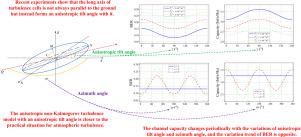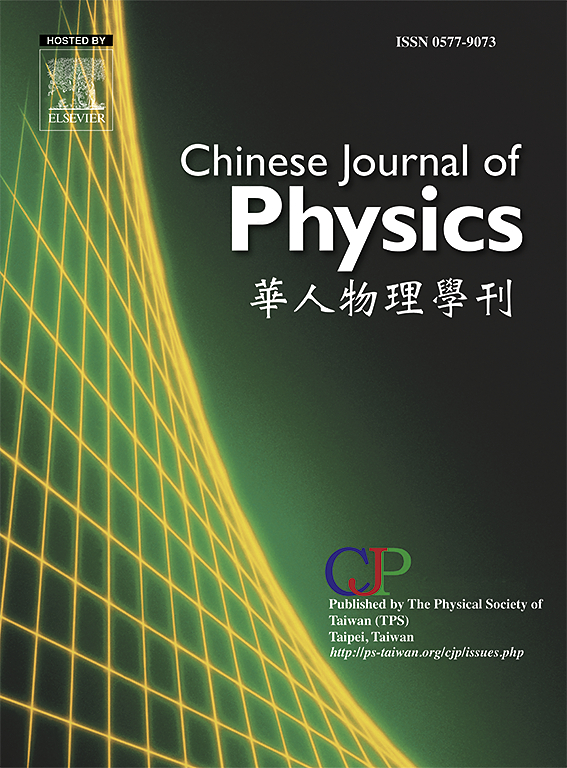涡旋伽玛光束在各向异性非柯尔莫哥洛夫大气湍流中传播的误码率和平均容量
IF 4.6
2区 物理与天体物理
Q1 PHYSICS, MULTIDISCIPLINARY
引用次数: 0
摘要
近年来,由于具有低误码率(BER)和高信道容量的能力,人们对自由空间光学(FSO)通信产生了极大的兴趣,特别是通过使用各种涡旋光束。目前的各向异性非kolmogorov (ANK)湍流模型大多假设湍流单元的长轴与地面平行。然而,Beason等人和Wang等人最近的实验发现表明,这些湍流单元可以表现出各向异性的倾斜角度,这意味着湍流单元的长轴并不总是平行于地面,而是与地面形成特定的角度。本文研究了一种新型涡旋波束——伽马波束及其在FSO通信中的应用。本文首次全面分析了伽玛光束通过具有各向异性倾斜角的弱到强ANK大气湍流时轨道角动量通道的平均容量和误码率。采用湍流池椭球模型,证明了OAM通道的平均容量随各向异性倾角γ的增大先增大后减小,且平均容量的变化在γ=90°周围是对称的。进一步的数值计算结果表明,通过选择较低的OAM拓扑电荷、使用较窄的接收机孔径和优化初始波束腰,利用伽马波束的FSO通信链路可以获得更高的信道容量。这些发现对于增强依赖于OAM的FSO通信系统是有希望的。本文章由计算机程序翻译,如有差异,请以英文原文为准。

Bit error rate and average capacity of vortex gamma beams propagating in anisotropic non-Kolmogorov atmospheric turbulence with anisotropic tilt angle
In recent years, there has been significant interest in free space optical (FSO) communications, particularly through the use of various vortex beams, due to their ability to offer low bit error rate (BER) and high channel capacity. Current anisotropic non-Kolmogorov (ANK) turbulence models mostly assume that the long axis of turbulence cells is parallel to the ground. Nevertheless, recent experimental findings by Beason et al. and Wang et al. have demonstrated that these turbulence cells can exhibit an anisotropic tilt angle, which means that the long axis of turbulence cells is not always parallel to the ground but instead forms a specific angle with it. This study investigates a new type of vortex beam known as the gamma beam and its application in FSO communications. For the first time, it provides a comprehensive analysis of the average capacity and BER of the orbital angular momentum (OAM) channels for a gamma beam transmission through weak-to-strong ANK atmospheric turbulence with an anisotropic tilt angle. The turbulence cell ellipsoid model is employed, and it is demonstrated that the average capacity of OAM channels initially increases and then declines as the anisotropic tilt angle increases, and the variation in average capacity is symmetric around . Further numerical results indicate that the FSO communication link utilizing the gamma beam can achieve higher channel capacity by selecting a lower OAM topological charge, using a narrower receiver aperture, and optimizing the initial beam waist. These findings are promising for enhancing FSO communication systems that rely on OAM.
求助全文
通过发布文献求助,成功后即可免费获取论文全文。
去求助
来源期刊

Chinese Journal of Physics
物理-物理:综合
CiteScore
8.50
自引率
10.00%
发文量
361
审稿时长
44 days
期刊介绍:
The Chinese Journal of Physics publishes important advances in various branches in physics, including statistical and biophysical physics, condensed matter physics, atomic/molecular physics, optics, particle physics and nuclear physics.
The editors welcome manuscripts on:
-General Physics: Statistical and Quantum Mechanics, etc.-
Gravitation and Astrophysics-
Elementary Particles and Fields-
Nuclear Physics-
Atomic, Molecular, and Optical Physics-
Quantum Information and Quantum Computation-
Fluid Dynamics, Nonlinear Dynamics, Chaos, and Complex Networks-
Plasma and Beam Physics-
Condensed Matter: Structure, etc.-
Condensed Matter: Electronic Properties, etc.-
Polymer, Soft Matter, Biological, and Interdisciplinary Physics.
CJP publishes regular research papers, feature articles and review papers.
 求助内容:
求助内容: 应助结果提醒方式:
应助结果提醒方式:


